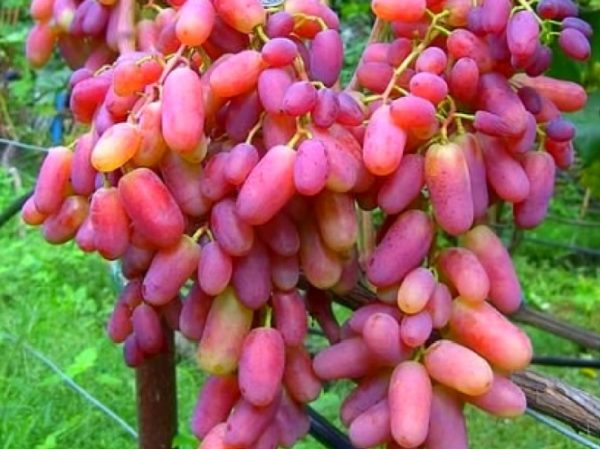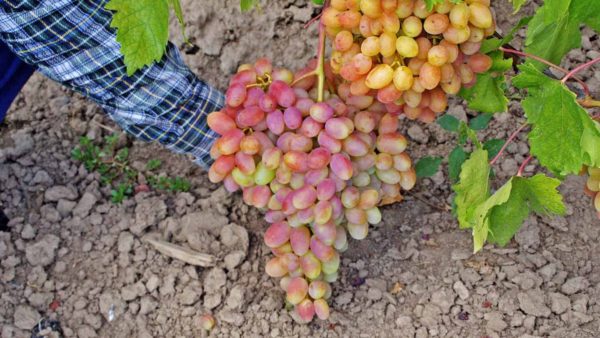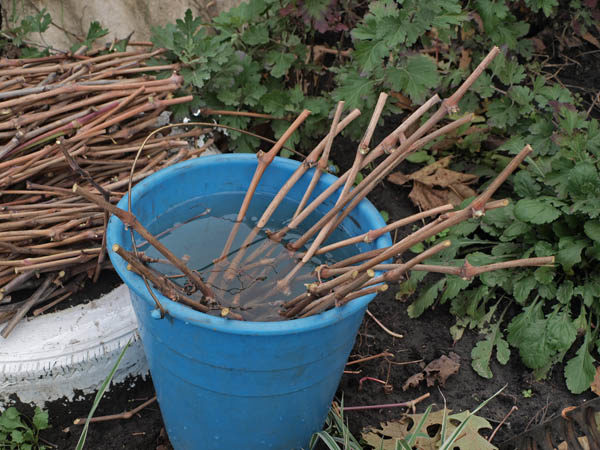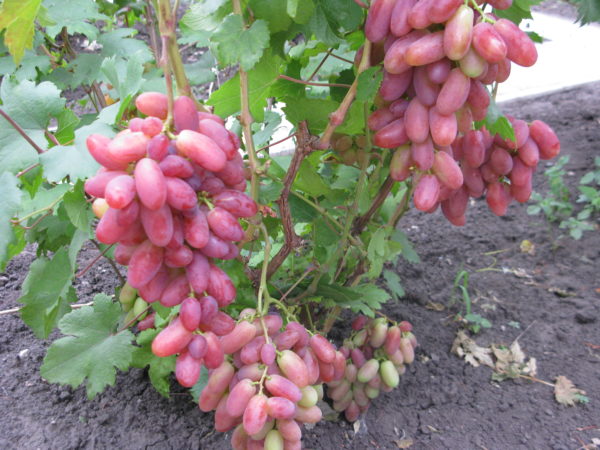There are many varieties of grapes, which complicates the choice of options for planting on your backyard. As an acquaintance with one of the worthy applicants, which has universal use, the variety Julian is proposed.
Table of contents
Description of a grade of grapes Julian
Let's talk about the description. Plant of early term of maturing with the period of vegetation of 95-105 days is the winner of the contest "Golden Cluster" in 2011, ahead of other candidates in two nominations at once: “The best form of private selection” and “The best sample of table grapes”.Appreciation was received quite deservedly, as confirmed by gardeners who have accumulated experience in growing this crop.
Julian combines in his qualities the virtues of parents, complemented by an early period of aging. Successful breeding work has become a real gift to consumers, a cocktail of superior characteristics makes the variety ideal for home cultivation. The average yield is 30-60 kg per bush.
You can enjoy ripe berries at the end of July. By this time, the grapes have enough sugar (up to 28%) and turn pink. Bushes are developing intensively, which requires a mandatory garter. The root system is strongly branched, the selected petioles are distinguished by good survival. A feature of the hybrid is considered the possibility of re-harvesting from stepchildren, but only under the condition of growing crops in the warm regions of the country. Attention is also attracted by the frost resistance of the plant, the temperature to minus 23 ° is tolerated normally.

The plant develops well and bears fruit in the southern regions of Russia, but some gardeners manage to grow sweet berries in the Moscow region, as well as in central areas. Wintering in this case provides shelter. Without it, the roots will freeze.
Characteristics of berries
On massive branches of a bush loose clusters with large berries are formed. The mass of one brush reaches 700-1000 grams, and sometimes with proper care, the indicator increases to 2 kg. On one whip 20-40 clusters are tied with finger-shaped berries about 4 cm long, weighing on average 20 grams. Color heterogeneous: on a green background as the maturity appears pinkish color of varying intensity. The skin is of medium density, but rather thin, practically not perceptible in the mouth.
Tastes differ in different shades, borrowed from the varieties of parents. The nutmeg note, sweetness and even strawberry shade is well felt.

The advantages and disadvantages of the variety
Considering all the characteristics of the Julian variety, the following advantages can be identified:
- early ripening of grapes;
- strong immunity, which is manifested in resistance to many diseases;
- high commercial quality;
- saturation of taste with different notes, sugar level;
- frost resistance of the plant;
- good yield.
It is important to note the fact that the hybrid is quite unpretentious to the neighborhood with other varieties. The taste and fruiting companion does not have a negative impact. Agrotechnology is clear and does not contain complex technology, so even an inexperienced gardener will be able to grow delicious berries on its land.
Julian has no significant shortcomings, except that there is a demanding attitude to the choice of landing point. It should be well lit without piercing wind. These factors adversely affect the development of bushes.
Landing
As the planting material used cuttings or seedlings. Cuttings are best planted in the spring, so that before the onset of winter, there is enough time to strengthen the root system. Saplings already have formed roots, so there are no strict time limits.
For the normal growing season of grapes requires a lot of lighting, so the place for planting should be chosen away from the buildings and the garden. It is better if the selected zone is not exposed to strong drafts. As a protection against the winds, it is recommended to install film screens.

Land a few days before planting should dig up (in two tiers). If the groundwater level is high, drainage should be provided. This will prevent rotting of the root system. Culture develops well in a neutral or slightly acidic medium, so if the soil is acidified, lime must be introduced into it (glass per 1 m2). Not bad with the task and dolomite copes. To make the soil fertile, it is recommended to enrich it with rotted manure, compost or mineral fertilizers. It is recommended to dilute the clay soil with sand to increase the permeability of moisture and air.
Chubuk grapes Julian planted in autumn or spring (October - March). If the climatic features of the region are distinguished by low temperatures and long winters, then it is better to postpone the planting until spring, so that the young cuttings have time to settle down for the summer, and by the autumn are able to get stronger enough. The main landmark that determines the planting time is soil temperature over 10 ° С.
When arranging the vineyard, take into account the interval between the bushes, which should not be less than 80 cm. The pit for the seedling is dug deep: depth - more than 70 cm, diameter - 65-75 cm. These parameters should not be scary, because part of the volume will be taken by the substrate (fertile soil, peat, compost). The rest of the place will be required by the root system, which will begin to grow rapidly. Experienced gardeners have noticed that when instilling cuttings in a shallow hole, the plant develops and bears little fruit.

Care for a young and mature vine
As with any other plant, grape seedlings need attention and care. The first is to take care of watering. If it is not possible to irrigate the young shoots regularly, it is recommended to equip the drip system or the underground one by laying pipes. Before the flowering period, the soil is moistened 1 time in 7-15 days. Watering activities stop during the berry pouring. Excessive moisture can cause cracking of the fruit.
The final watering is carried out a week before the grapes shelter for the winter.
Once a year, basal fertilizing from organic matter is introduced. Compost and rotted manure are used as fertilizer. For irrigation (before the flowering period) use of ash solution is allowed. Feeding with ashes bush can also fall after the harvest.

In order to prevent overloading of bushes, pruning of extra inflorescences and bunches is done. About 40-45 brushes are left on one plant. Pruning of the vine is done on 8-10 eyes.
To protect the soil from drying out it is mulched after planting seedlings. When using organic materials the need for dressings disappears. Reverse hay or sawdust feeds the soil with beneficial trace elements.
Breeding methods
Grapes multiply in several ways: cuttings, seedlings, using layering. Seed variant is not suitable, when growing seedlings out of the stone, taste and other qualities of the variety are lost.
The layering involves the addition of a process by a layer of earth for rooting, but this method allows you to grow a small number of shoots. The most common type of breeding is the use of seedlings, which are obtained as a result of rooting cuttings. This method and is used for planting varieties Julian.

Diseases and pests
Julian variety is valued for strong immunity, which is expressed in the resistance of the plant to various diseases. However, this does not mean that the culture is not in danger. The main danger of the variety are the following diseases:
- gray rot;
- oidium;
- anthracnose;
- mildew (downy mildew).
Do not wait for the disease to manifest itself on the foliage or stem of the plant. It is better to do preventive measures:
- from oidium use a solution of colloidal sulfur;
- from fungal infections - Bordeaux fluid.
Systematic examinations of the bushes will help regulate watering and preventive treatment. If the culture is still struck by a disease, you need to localize the problem by spraying using one of the appropriate drugs: Cupricol, Abiga-peak, Topaz, Hom, etc.Of the stronger means (in composition and effects) are used: Fundazol, Euparin, Sumileks.
In general, the agricultural technology of grapes Julian is not difficult. Unpretentious care and excellent taste made the berry popular in a short period of time. It's time to get on your site really fertile plant with sweet fruits.
